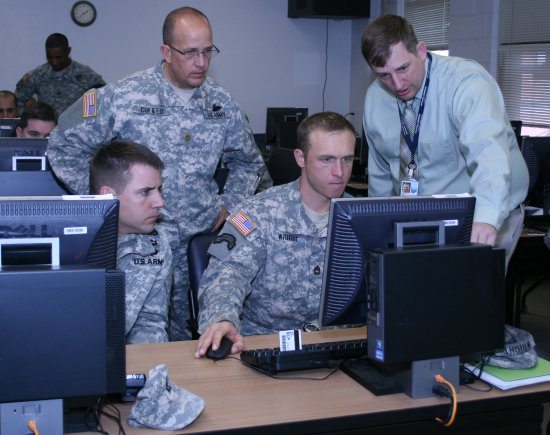As drawdowns in Afghanistan continue, Army officials are shifting focus on homefront training, beginning with how the training is organized and scheduled.
In an effort to help facilitate this shift, a team of civilian government service workers and Lt. Col. Damon Pfaltzgraff traveled to Fort Carson from the Training Management Directorate at the Combined Arms Center for Training, headquartered at Fort Leavenworth, Kan., to help educate Soldiers on the digital training management systems available.
“The two-day training is enough to give them an idea of what is there, but it’s up to each installation to develop the skills and proficiency,” said Pfaltzgraff, team lead for the Training Management Mobile Training Team.
The team began its tour at Fort Carson, facilitating a two-day course, Nov. 27-28, for more than 40 noncommissioned officers and officers from various units.
When the wars started, “Big Army” shifted to “top-down”‘ training — providing a checklist based on the challenges Soldiers faced in theater and said, “This is what you have to do,” said Pfaltzgraff.
Before the conflicts in Iraq and Afghanistan began, commanders had to anticipate missions and determine training accordingly, Pfaltzgraff said.
“With the high operation tempo, we got away from that,” he said. “As we look to come out of Afghanistan, a lot more units will be operating at home. There will be competition for training equipment and ranges.”
With the shift from counterinsurgency training to decisive action training, Pfaltzgraff said the approach to training will switch from the “top-down” approach to “bottom-up,” with platoon and company leadership determining training objectives and negotiating with battalion commanders to achieve those goals.
“If a commander decides his unit needs ‘movement to contact’ training, there are so many tasks needed before that final mission can be successfully completed,” he said.
Instead of flipping through hundreds of pages in training manuals, Soldiers may access unit training plans through a digital collection of materials, including Unit Training Management on the Army Training Network, Digital Training Management System and the Combined Arms Training Strategies.
Representatives from the Training Management Mobile Training Team led Soldiers through the online systems, guiding them on how to develop training plans, execute training and perform after action reviews.
“This is a one-stop shop for all training resources,” said Maj. John McNamara, 4th Engineer Battalion. “The ability to reference all of the Army training resources in one location makes it easier to understand Army training doctrine.”
Master Sgt. Kenya Smith, 43rd Special Troops Battalion, 43rd Sustainment Brigade, said after the training he no longer had to spend hours looking up information in paper manuals.
“This makes it faster and there’s less waste,” he said. “Technology rules.”










